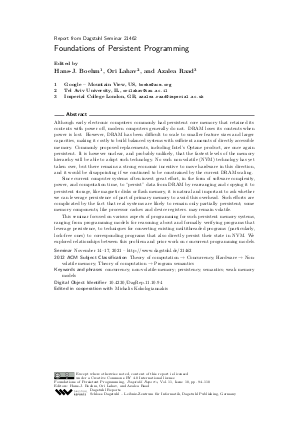Foundations of Persistent Programming (Dagstuhl Seminar 21462)
Authors Hans-J. Boehm, Ori Lahav, Azalea Raad and all authors of the abstracts in this report
-
Part of:
Issue:
Dagstuhl Reports, Volume 11, Issue 10
Part of: Volume: Dagstuhl Reports, Volume 11
Part of: Journal: Dagstuhl Reports (DagRep) - License:
 Creative Commons Attribution 4.0 International license
Creative Commons Attribution 4.0 International license
- Publication Date: 2022-04-11
File

PDF
DagRep.11.10.94.pdf
- Filesize: 2.47 MB
- 17 pages
Document Identifiers
Subject Classification
ACM Subject Classification
- Theory of computation → Concurrency
- Hardware → Non-volatile memory
- Theory of computation → Program semantics
Keywords
- concurrency; non-volatile-memory; persistency; semantics; weak memory models
Metrics
- Access Statistics
-
Total Accesses (updated on a weekly basis)
0Document
0Metadata
Abstract
Although early electronic computers commonly had persistent core memory that retained its contents with power off, modern computers generally do not. DRAM loses its contents when power is lost. However, DRAM has been difficult to scale to smaller feature sizes and larger capacities, making it costly to build balanced systems with sufficient amounts of directly accessible memory. Commonly proposed replacements, including Intel’s Optane product, are once again persistent. It is however unclear, and probably unlikely, that the fastest levels of the memory hierarchy will be able to adopt such technology. No such non-volatile (NVM) technology has yet taken over, but there remains a strong economic incentive to move hardware in this direction, and it would be disappointing if we continued to be constrained by the current DRAM scaling. Since current computer systems often invest great effort, in the form of software complexity, power, and computation time, to "persist" data from DRAM by rearranging and copying it to persistent storage, like magnetic disks or flash memory, it is natural and important to ask whether we can leverage persistence of part of primary memory to avoid this overhead. Such efforts are complicated by the fact that real systems are likely to remain only partially persistent; some memory components, like processor caches and device registers. may remain volatile. This seminar focused on various aspects of programming for such persistent memory systems, ranging from programming models for reasoning about and formally verifying programs that leverage persistence, to techniques for converting existing multithreaded programs (particularly, lock-free ones) to corresponding programs that also directly persist their state in NVM. We explored relationships between this problem and prior work on concurrent programming models.
Cite As Get BibTex
Hans-J. Boehm, Ori Lahav, and Azalea Raad. Foundations of Persistent Programming (Dagstuhl Seminar 21462). In Dagstuhl Reports, Volume 11, Issue 10, pp. 94-110, Schloss Dagstuhl – Leibniz-Zentrum für Informatik (2022)
https://doi.org/10.4230/DagRep.11.10.94
BibTex
@Article{boehm_et_al:DagRep.11.10.94,
author = {Boehm, Hans-J. and Lahav, Ori and Raad, Azalea},
title = {{Foundations of Persistent Programming (Dagstuhl Seminar 21462)}},
pages = {94--110},
journal = {Dagstuhl Reports},
ISSN = {2192-5283},
year = {2022},
volume = {11},
number = {10},
editor = {Boehm, Hans-J. and Lahav, Ori and Raad, Azalea},
publisher = {Schloss Dagstuhl -- Leibniz-Zentrum f{\"u}r Informatik},
address = {Dagstuhl, Germany},
URL = {https://drops.dagstuhl.de/entities/document/10.4230/DagRep.11.10.94},
URN = {urn:nbn:de:0030-drops-159303},
doi = {10.4230/DagRep.11.10.94},
annote = {Keywords: concurrency; non-volatile-memory; persistency; semantics; weak memory models}
}
